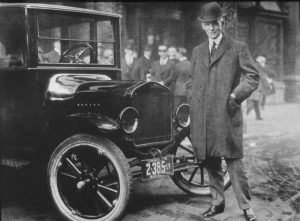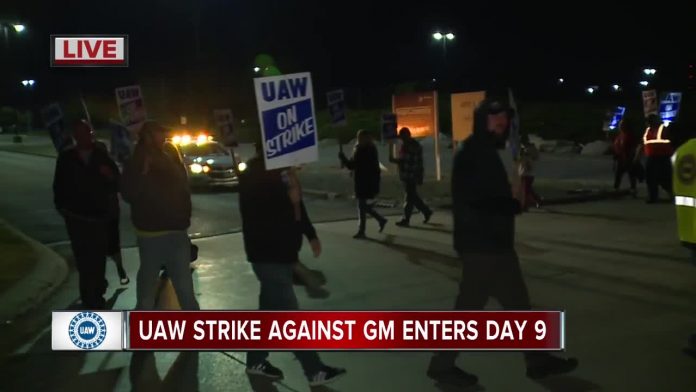Lost in the fatuous fake news juggernaut about the supposed misdeeds of the relentlessly besieged Orange Man has been real – and important news – about the longest nationwide strike by autoworkers in almost 50 years.
The target of the strike is General Motors. The United Auto Workers haven’t been working since September 16. Almost all GM plants have been idled since then, with the exception of the truck plant in Silao, Mexico. But a shortage of parts caused by the idling of the plants north of the border will almost certainly cause the truck plant to go silent soon, too.
The closures are costing GM about $25 million per day in lost profit, according to analysts.
But they could cost autoworkers – and us – much more.
The UAW is wangling with GM over several things, including some of the usual things such as wages, health care and job security.
That last item is italicized to emphasize something brewing that’s extremely newsworthy but isn’t being reported much by the general press, probably because it almost never reports anything that is alarming about the EV juggernaut.
One of those things is what the force-feeding of electric cars will do to car industry jobs – and not temporarily.
An EV is a transportation module with fewer parts that is much easier to assemble than a non-electric car. It requires fewer workers to manufacture – and maybe not any at all. It is likely that an EV production line could be almost completely automated.
Many plants – not just GM’s – will be closing and not temporarily, because of a labor dispute.
Also plants that used to build engines and transmissions (EVs don’t have them) as well as all the peripheral systems, many of which EVs also do not have. The EVs themselves are largely disposable, too. Like a smartphone.
This has happened before, of course – but very differently.
The horse-and-buggy industry gave way to the car industry at the beginning of the 20th century – but organically. Because cars were functionally superior to the horse and buggy. When they became much cheaper than a horse and buggy – the breakthrough achieved by Henry Ford with his assembly line technique and mass production of the Model T – almost everyone except the Amish gave up their horse and buggy – and they kept theirs for religious reasons.
Today, we’re being forced for religious reasons to give up our cars in favor of the modern analog of the horse and buggy.
Whatever putative merits EVs may have, according to those pushing them – the facts about their much higher cost, much reduced operating range and much increased time to resume operation are incontestable. Ordinarily, these facts would prevent them from being mass produced for all the obvious reasons – the most obvious one being that the masses are as unlikely to buy EVs as people in the 1950s were likely to buy horses and buggies.
But the difference is that people are going to be forced to buy EVs.
They are already being forced to “help” defray the cost of mandates requiring the manufacturing of them, via higher prices for non-electric cars – and they’re forced to “help” the few who do want them to buy them, via taxpayer-financed subsidies.
But that won’t be enough to get most people into an EV.
It will be necessary to make non-EVs cost at least as much – and maybe more than – EVs. This will be done via “polluter pays” annual registration fees (these being based on the religious fatuity that carbon dioxide is a “pollutant” . . . but only when “emitted” at the tailpipe) and incrementally expanding bans on the use of other-than-electric cars; first in urban areas, then spreading outward.
This will create “demand” for EVs – in the Five Year Plan Sense of top-down-decreed artificial demand for them. It is considered an irrelevance by the five-year-planners whether the people downstream want – or can afford – any of this.
Regardless, the EVs will be mass-manufactured. And there will be fewer workers involved in their manufacture. Just as there will be fewer over-the-road (and delivery) drivers, once the automated electric car is foisted upon us.
GM will permanently close and consolidate more plants – and so will the rest of the industry. “Productivity” will go up, but wealth will not be created.
It will be transferred.
From the bottom of the pyramid to the apex.
In addition to paying more for cars – now electric exclusively – people will be forced to pay the social costs of all those workers no longer working. It will be paid in more than money, too. There will be a growing anger, born of frustration and hopelessness.
This is not capitalism – but it will be demagogued as such by people who know better, who will demagogue it to use and manipulate its victims – the autoworkers, for instance. Who will be victimized twice, at least.
First, they’ll lose their jobs – not because those jobs have been rendered obsolete but because they’ve been legislated out of existence. Then they’ll become desperate, comparable jobs (and income) probably not being available. Then they’ll become dependent – on demagogues, who will urge more of the same poison – government, always government – which caused them to be victimized in the first place.
EVs will lead to the proletarianization of America. Reversing the gains made by average people over the past 120 years.
The UAW strike is a prequel of things to come.
. . .
Got a question about cars, Libertarian politics – or anything else? Click on the “ask Eric” link and send ’em in!
If you like what you’ve found here please consider supporting EPautos.
We depend on you to keep the wheels turning!
Our donate button is here.
If you prefer not to use PayPal, our mailing address is:
EPautos
721 Hummingbird Lane SE
Copper Hill, VA 24079
PS: Get an EPautos magnet (pictured below) in return for a $20 or more one-time donation or a $10 or more monthly recurring donation. (Please be sure to tell us you want a sticker – and also, provide an address, so we know where to mail the thing!)
My latest eBook is also available for your favorite price – free! Click here. 












The United Steel Workers and Bethlehem Steel supposedly had a line in the contract that said no blue hat could be laid off for “technological advancement.” The USW probably saw that electric arc furnaces were replacing blast furnaces because the need for new steel was falling rapidly in the late 1960s, and what new steel was needed was being bought from overseas plants. Bethlehem didn’t care, because they weren’t willing to make the investment in electric furnaces while the old stuff was still cranking out product, mostly for the military and civil projects like roads.
Then the ’70s recession hit. Then Viet Nam ended. And the Interstates were finished out. Followed by the end of the northeast skyscraper boom. Everyone blamed Japanese subsidies, which were a factor, but those paid-for plants cost a fortune to run at anything less than full capacity. Electric furnaces require CapEX spending, and that cuts into the dividend. Plant mangers had to face the facts that the industry had changed and they ignored it. And in the case of the Johnstown PA plant, the newly empowered EPA decided that the Stony Creek river was too polluted with sulphur, and instead of going after the abandoned coal mines, decided that Bethlehem Steel was the culprit. Never mind that there’s no sulphur used in steelmaking, never mind that all Bethco did was quench steel and send it back out the river, they had to treat all the water that came through the plant. I still remember seeing the fish tank at the General Offices with giant trout living in filtered river water. Those fish were living in what was probably the most expensive fish tank in the world (and the only living things in Stony Creek). Years later the Simpsons did a story about a 3 eyed fish caught downstream of the nuclear plant that reminded me of those trout.
Now they had to modernize plants, shut down others and figure out how to operate in the changed market. Unfortunately they weren’t successful. One big reason is because of that clause in the contract. They had workers come in, sit in the break room all day and then go home. I think they tried to do some retraining, but because it didn’t matter, most of the workers just blew it off. They finally started shutting down plants and handing out pink slips. If you were lucky you might have been able to relocate to Burns Harbor. If not, well, there’s always unemployment assistance and working off the books.
Now those plants still stand, but the company, the workers and the work is all gone. Oh and the water treatment plant too. A few small startups occupy a fraction of the space, but nothing like back in the day. Was it because of the idle workers? Failure to see the change? Uncle changing the rules? Don’t know, but I did learn that about the time you start to feel good about work that’s the time you need to be thinking about where your next meal is coming from. I see it in my cable industry right now, where we’re about to get a full court press of competition, but I’m hearing quotes like “Eh, we had competition from Dish and Direct TV, so Verizon and AT&T won’t be a problem.” Ok, keep thinking like that. In the meantime I’ll be working on my next career.
Related but OT: https://www.zerohedge.com/energy/11-tons-water-and-special-container-used-extinguish-burning-tesla-austria
Most people, especially the elite, have no idea the massive social upheaval that will happen even with just automating trucking, let alone anything else. Trucking represents nearly four million jobs for people. People that would have great difficultly finding other useful work. And there are tons of other industries that are close to automating, shedding millions of other jobs too.
Remember that horse and buggy to cars still took close to forty years to play out. They ain’t willing to take forty years to phase out personal cars. Once the tech is just good enough, those people will be pink slipped.
I won’t be selling my horses any time soon. I’m serious.
Meet The New Electric Car That Doesn’t Need To Be Plugged In
https://returntonow.net/2019/09/28/meet-new-cordless-electric-car-that-emits-only-water-vapor/
[excerpt]
“There’s a new kind of electric car on the block. It’s called a fuel-cell electric vehicle, or hydrogen car. Unlike a traditional electric vehicle, there is no heavy battery to store electricity, often created by fossil fuel.”
“Instead, the car pulls in oxygen from the air and mixes it with hydrogen, stored in its tank, to produce a steady supply of electricity as the car runs.”
“Hydrogen-electric cars are zero-emissions vehicles, which produce nothing but water vapor as a byproduct. What comes out of the tailpipe is so pure, you can drink it.”
“One major advantage of hydrogen cars is they have a much longer driving range than traditional electric cars.”
Hi Adam,
Yup; only it’s not new! I remember fuel cell concept cars back in the early ’90s. Neat idea. Expensive idea. Unless something has changed, much more expensive than a battery-electric car.
I hear anhydrous ammonia is a much cheaper fuel cell with national distribution already in place but….methamphetamine and such.
You are aware that water vapor actually IS a greenhouse gas capable of trapping heat? It’s not just life giving CO2 which is a climate changer. So that’s not an out for resisting the green/red insanity.
TANSTAAFL.
Also hydrogen is very hard to store and handle, and much more explosive than traditional hydrocarbon natural fuels.
Having said all that, it is an interesting field of scientific inquiry and experimentation.
Ernie,
“ Also hydrogen is very hard to store and handle, and much more explosive than traditional hydrocarbon natural fuels”
Oh!
The humanity!
But the good news is, “ Hydrogen fires are less destructive to immediate surroundings than gasoline explosions because of the buoyancy of H2, which causes heat of combustion to be released upwards more than circumferentially as the leaked mass ascends in the atmosphere; hydrogen fires are more survivable than fires of gasoline or wood.[21] The hydrogen in the Hindenburg burned out within about 90 seconds.”
Fake news. I’ve been around hydrogen vehicles. It takes enormous amounts of electricity to extract hydrogen either through electrolysis or from natural gas. Electrolysis will offend climate cultists, as it produces large amounts of CO2. Storage and dispensing of gaseous hydrogen (at 10,000 psi 😳) is very dangerous, especially since leaks are practically undetectable and have a tendency to spontaneously combust. The “hydrogen highway” is about as likely as nuclear fusion.
The two go hand-in-hand. Fusion power too cheap to meter (HA), cracking water atoms for hydrogen. H2 becomes the energy transport medium instead of the source. Sounds great except that 1) Mr Fusion is way, way off. 2) The membrane used in fuel cells clogs fairly quickly and has to be regularly replaced.
Fuel cells were great for short duration trips where you have pure cryogenic oxygen and hydrogen anyway, like in spacecraft, but for you daily driver… forget about it.
Upside of hydrogen as a transport fuel is that it does dissipate fairly quickly outdoors, so if there is a leak as long as it’s not trapped it shouldn’t be too big of a problem. But storage is still a big issue, needing carbon fiber or other thick tanks because the hydrogen atoms will tend to migrate though most materials.
Great idea! Invest your own money in that and let us know how it works out.
Eric:
(1) re: GM strike. The timing is, to say the least, rather suspicious. Either the UAW leadership has gotten “stoopid”, which would be no shock, or else this whole thing is for show, e.g., the real “deal” has already been struck, with GM getting a nine-day or so break from paying the striking workforce while they retool for the new model year, and the UAW leadership appears to be doing SOMETHING for those copious union dues. Of course, never forget what the real “bosses” (whether it be the fictional Tony Soprano or “Fat Tony” DiMicco of the Simpsons, who cares) whom want their hands on those cushy union PENSION accounts have in mind.
(2) Like the much-ballyhooed solar energy scam, EVs are not new, and the fundamental technology is the same as the Riker electric vehicle of 1895. Yes, batteries have improved remarkably in some 125 years, but the penalties of cost and weight, relative to how much range the vehicle gets, and the ability to recharge in a TIMELY manner doom the “pure” EV concept to specialized vehicles, if the market is ALLOWED to govern.
(3) I should wonder what would happen, if, perchance, I came into some capital and decided to attempt mine own idea, starting with some old, usable junker, like a discarded Geo Metro, and making mine own hybrid? I have this idea of using a small diesel, powering a generator-motor, and also having a hydraulic direct-drive, not unlike what Preston Tucker originally envisioned for the “Torpedo” prototype. The advantage of this contraption would be a relatively simple ability to match torque demands, and also, upon deceleration, recapture some of the braking energy (commonly lost in most conventional setups as heat through the brake pads and rotors)..PLUS…the diesel, running at only a set speed (to match the synchronous generator) to optimize its performance, which inherently the diesel cycle is best suited for, will deliver the best possible fuel economy and lowest emissions. Engineering-wise, methinks this is hardly any more complicated than the 2014 Ford Focus that I’ve used for five years as my daily driver. But get this damned contraption working, and I’ll wager the bureaucrats will do their damned-nest to ensure it never hits the road!
Good stuff on 1 and 2 Douglas. Thanks
BTW, my brother, a smart engineer, built his own EV out of donor civic I think. He was soooo excited, until……….he had to add heat to the thing, add: etc…., etc…..
I think it ended up going 30 miles +/-. he sold it to another aspiring engineer for the high tech batteries and motor costs.
Ultimately, there’s only one real solution for our current economic and political total constipation:
Fifty megatons on the Capitol Dome during a State of the Union Address, thus killing all the rats in the nest. True, there’d be a few collateral casualties, but one can’t make an omelet without breaking a few eggs, as the Marxists were fond of saying.
Hi John,
It’s a measure of just how bad things are that I can’t argue with that prescription…
Yeah, but the problem is that it’s the GOVERNMENT who has the 50 megatons that their disposal… not YOU.
That and it might damage one of my favorite cheese-steak vendors location in Alexandria, VA.
shucks man, they’s just be more well done…
Eric,
Ever read Clancy’s Debt Of Honor?
“Killing” the puppets won’t stop the puppet show for long.
I wonder if there will be enough minerals, which are somewhat scare when compared to oil, gas and goal, available to build the batteries for these stupid monstrosities. As with solar and wind, there are limits to harnessing and storing that energy despite the sun always shining and the wind always blowing. And of course, other fuel materials are also limited as to what is available from the earth itself. Resources, as they are used today, are somewhat limited, except for maybe nuclear power.
The difference is in the word force. Capitalism doesn’t force much of anything, while socialism forces most of everything and that is because most people grow to hate socialism once they have gotten a taste of it. I still do not see how jobs being replaced by robots or eliminated all together is going to allow more people to buy EV’s or really anything.
The bottom line is that the extremists are power hungry control freaks who hate themselves and everyone who does not believe in their crap. It’s no longer about practicality and prosperity, but about bring us back to the stone age…fewer cars, less energy and fewer people. Will the world stand for it?
Here’s a mind numbingly simple solution.
All revenues earned in the US are taxable at the going Corporate tax rate (35%).
The only deductible expenses are those incurred in the United States.
Problem solved: a two line 25 word Act of Congress.
Imagine the whining from the usual special interests.
Ram beat Silverado again for a third quarter in a row.
Hi Brazos,
Thanks for getting to that before I could! The news made my day 🙂
Sales are dropping hard across the board though. Nissan is in a blood bath. I love the way the new titans look and the endurance V8 but they are so bloated with useless technology compared to old dependable nissan.
Hi Brazos,
Yup. Nissan is on my Dead Pool list… it may happen sooner than people expect.
GM also came out with the same line of “if we add GMC sales too we are still on top!”
Glad UAW is on strike and GM is bleeding cash, at some point reality has to hit and sales dry up because no one wants an EV.
Automation is going to break society.
No jobs = no mass of consumers. No mass of consumers means a rapid descent techno-fudalism.
Own nothing, rent everything, gig economy servicing the Lords. Sound familiar?
Hi Anon,
See this: https://www.youtube.com/watch?v=Ucv7ZYGaLCM
That was depressing.
WTF?
Manbun Soyboys paying $1,200 a month to basically live in a prison setting? This isn’t even one step up from Mom’s basement.
Dammit, Guerrero!
“Manbun soyboys”… I wasn’t clinched up and peed myself a bit, just now…
The concept: Good looking young people sharing sleeping quarters (and STDs). Where do I sign up?
Reality: lots of people who’s funk isn’t compatible with your funk.
I remember a story about Henry Ford telling Walter Reuther (president of the UAW back then) that he envisioned the day when assembly lines would be completely automated, no humans involved. Mr. Reuther replied “well then I hope those robots will be buying your cars, because nobody else will be able to”.
One thing I learned in college that changed my understanding of things was this:
‘You have to create something out of raw materials to create real wealth.’
So Eric, you are right on saying most, if not all, of the current games are just manipulations of transferring wealth.
Thank you for reminding me.
Thanks, Chris!
It’s important we all remember it – and remind others, too!
writing a test sentence for word press. 123
I was reading an article on Market Watch, and guess which vehicles are stolen the most? Big powerful ones with V8 engines like the Dodge Charger, Chrysler 300, and the Hellcat topped the list! Full size trucks with V8s are also popular with thieves. Among the LEAST stolen cars were EVs.
Here’s the article about the vehicles thieves prefer: https://www.marketwatch.com/story/relax-tesla-drivers-thieves-dont-want-your-electric-cars-2019-08-01
Hi Mark,
Yup – and do you know why? A stolen EV can be bricked as soon as it is reported stolen. This is a perk for the owner, of course. But that “perk” can also be used to brick cars for other reasons…
I thought thieves desired big V8 cars for more basic reasons: i.e. it’s what their “buyers” want; I attributed it to simple market forces… 🙂
BTW, a couple of BMWs made the list of least stolen vehicles too.
With the increasing nanny tech in modern cars, can’t a modern ICEV be bricked also?
They have been able to be bricked for quite some time. I remember reading an article about that in 1993 where cops were deploying a form of electromagnetic
directed energy weapons at cars trying to outrun them. Of course, it was pretty crude back then, but the idea was there with regular cars available at the time.